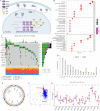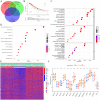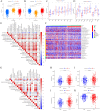m5C regulator-mediated methylation modification phenotypes characterized by distinct tumor microenvironment immune heterogenicity in colorectal cancer
- PMID: 37488178
- PMCID: PMC10366215
- DOI: 10.1038/s41598-023-37300-z
m5C regulator-mediated methylation modification phenotypes characterized by distinct tumor microenvironment immune heterogenicity in colorectal cancer
Abstract
The RNA 5-methylcytosine (m5C) modification has been demonstrated to be an important epigenetic regulator and to impact colorectal cancer (CRC) progression. However, the potential roles of m5C modification in immune cell infiltration in the CRC tumor microenvironment (TME) remain unknown. The m5C modification phenotypes were comprehensively evaluated based on 14 m5C regulators in a meta-CRC cohort of 1792 patients and systematically correlated with the m5C modification phenotypes, immune cell infiltration characteristics and known biological processes. The m5Cscore model was constructed by principal component analysis (PCA) algorithms to quantify the m5C modification phenotypes of individual CRC samples and was used to predict the immunotherapy response. We identified three m5C modification phenotypes associated with distinct clinical outcomes and biological processes among the 1792 meta-CRC patients. Three phenotypes with a highly consistent TME landscape and characteristics were revealed: immune excluded, immune desert and immune inflammation. The meta-CRC patients were divided into high and low m5Cscore subgroups based on the m5Cscore. The m5Cscore was confirmed to have a negative correlation with infiltrating immune cells and PD-L1 expression and a positive correlation with tumor mutation burden (TMB), mutation rate and microsatellite instability (MSI) score. Moreover, patients in the low m5Cscore group had better immunotherapy responses and significant durable survival benefits in independent anti-PD-1/L1 immunotherapy cohorts for the immune checkpoint inhibitor (ICI) therapeutic strategy. This study revealed that m5C modification plays a crucial role in TME composition and complexity. Comprehensive evaluation of the m5C modification phenotypes of individual patients will enhance our understanding of TME characteristics and promote the application of more appropriate and personalized treatment strategies.
© 2023. The Author(s).
Conflict of interest statement
The authors declare no competing interests.
Figures









Similar articles
-
m5C methylation modification may be an accomplice in colorectal cancer escaping from anti-tumor effects of innate immunity-type I/III interferon.Front Immunol. 2025 Jan 10;15:1512353. doi: 10.3389/fimmu.2024.1512353. eCollection 2024. Front Immunol. 2025. PMID: 39867908 Free PMC article. Review.
-
m5C regulator-mediated modification patterns and tumor microenvironment infiltration characterization in colorectal cancer: One step closer to precision medicine.Front Immunol. 2022 Dec 1;13:1049435. doi: 10.3389/fimmu.2022.1049435. eCollection 2022. Front Immunol. 2022. PMID: 36532062 Free PMC article.
-
5-Methylcytosine (m5C) Modification Patterns and Tumor Immune Infiltration Characteristics in Clear Cell Renal Cell Carcinoma.Curr Oncol. 2022 Dec 31;30(1):559-574. doi: 10.3390/curroncol30010044. Curr Oncol. 2022. PMID: 36661693 Free PMC article.
-
m6A regulator-mediated methylation modification patterns and tumor microenvironment infiltration characterization in gastric cancer.Mol Cancer. 2020 Mar 12;19(1):53. doi: 10.1186/s12943-020-01170-0. Mol Cancer. 2020. PMID: 32164750 Free PMC article.
-
Immunotherapy in colorectal cancer.Adv Cancer Res. 2021;151:137-196. doi: 10.1016/bs.acr.2021.03.002. Epub 2021 Jun 7. Adv Cancer Res. 2021. PMID: 34148613 Review.
Cited by
-
m5C methylation modification may be an accomplice in colorectal cancer escaping from anti-tumor effects of innate immunity-type I/III interferon.Front Immunol. 2025 Jan 10;15:1512353. doi: 10.3389/fimmu.2024.1512353. eCollection 2024. Front Immunol. 2025. PMID: 39867908 Free PMC article. Review.
-
The Quiet Giant: Identification, Effectors, Molecular Mechanism, Physiological and Pathological Function in mRNA 5-methylcytosine Modification.Int J Biol Sci. 2024 Nov 18;20(15):6241-6254. doi: 10.7150/ijbs.101337. eCollection 2024. Int J Biol Sci. 2024. PMID: 39664561 Free PMC article. Review.
-
RNA m5C modification: from physiology to pathology and its biological significance.Front Immunol. 2025 Apr 30;16:1599305. doi: 10.3389/fimmu.2025.1599305. eCollection 2025. Front Immunol. 2025. PMID: 40370440 Free PMC article. Review.
-
NOP2-Mediated m5C Methylation Modification of LMNB2 mRNA Facilitates Colorectal Cancer Progression.Cancer Med. 2025 May;14(10):e70970. doi: 10.1002/cam4.70970. Cancer Med. 2025. PMID: 40366008 Free PMC article.
-
The epigenetic landscape in intestinal stem cells and its deregulation in colorectal cancer.Stem Cells. 2024 Jun 14;42(6):509-525. doi: 10.1093/stmcls/sxae027. Stem Cells. 2024. PMID: 38597726 Free PMC article. Review.
References
-
- Pietro B, Filip S, Angana R, et al. MODOMICS: A database of RNA modification pathways. Nucleic Acids Res. 2021;2022(50):231–235. doi: 10.1093/nar/gkab1083. - DOI
Publication types
MeSH terms
Substances
LinkOut - more resources
Full Text Sources
Medical
Research Materials

